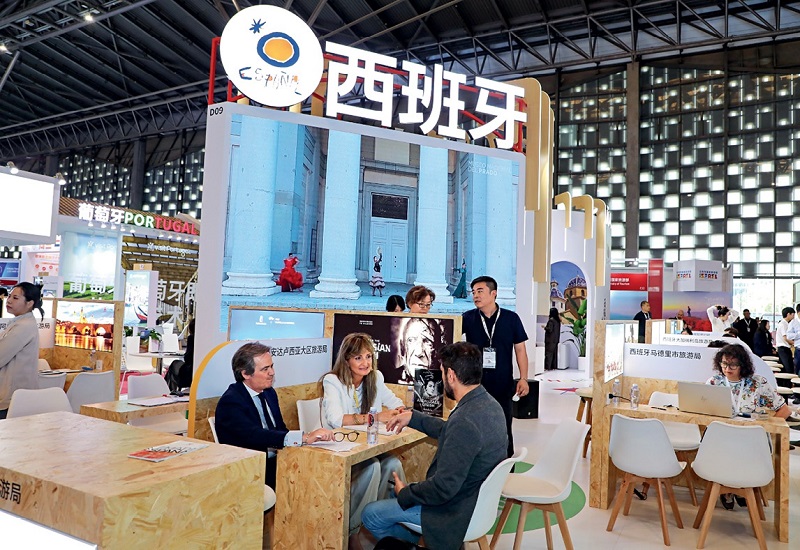Reaffirming its commitment to strengthening ties with China, Spain underscores its role as a bridge between Europe and China in a shifting global landscape.

At ITB China 2025, Spain’s booth promotes the country’s tourism.
Just days before Spanish Prime Minister Pedro Sánchez embarked on his third official visit to Beijing in April in less than three years, the Spanish government hosted a high-level meeting at the Moncloa Palace in Madrid with five prominent Spanish China experts specializing in bilateral relations and continental ties with Beijing. I was honored to join this select group for a three-hour exchange of views with Prime Minister Sánchez and his team – a conversation marked by candor and strategic vision.
In navigating today’s complex geopolitical landscape, particularly amid the Trump administration’s trade war, which has targeted not only China but also his former EU allies and much of the world, Sánchez has adopted a stance that is both national and pro-European. This balance was underscored when U.S. Treasury Secretary Scott Bessent warned on April 9 that deepening ties with China to counter tariff disputes would be “like cutting your own throat.” Yet Spain’s leader has remained steadfast in prioritizing dialogue over division.
My overall impression of the discussion was profoundly positive, not least because of Sánchez’s intimate understanding of and commitment to Spain’s relationship with China, rooted in over half a century of engagement. The year 2025 marks two milestones: the 20th anniversary of the Spain-China comprehensive strategic partnership and the 50th anniversary of the establishment of diplomatic relations between the EU and China. In fact, during his nearly seven years in office, Sánchez has met Chinese President Xi Jinping four times, beginning with Xi’s state visit to Madrid in November 2018.
Chinese Ambassador to Spain Yao Jing highlighted the strength of this bond in an April interview with the Spanish daily El Mundo, noting, “Our president and Sánchez share an excellent rapport built on trust.” That trust was on full display on April 11, when Xi and Sánchez met at the Diaoyutai State Guesthouse – both donning lilac-colored ties. The two sides unveiled the Action Plan for Strengthening the Comprehensive Strategic Partnership (2025-2028).
The 10-page document opens with a shared commitment: amid profound global changes over recent decades, China and Spain remain steadfast in upholding the multilateral system and deepening political dialogue. It also announces that King Felipe VI is expected to make a state visit to China in November, a gesture rich in symbolism.
Historically significant, Spainish King Juan Carlos became the first European monarch to visit the People’s Republic of China in June 1978, just months before the beginning of China’s reform and opening-up drive.
This preceded visits by Denmark’s Queen Margrethe II (1979) and the U.K.’s Queen Elizabeth (1986). Since Spain has historically seen itself as a bridge reaching out to other continents and civilizations, in this particularly significant year for the relationship between our country and our continent, and China, the invitation underscores the country’s role as a diplomatic catalyst between Europe and China.
Sánchez has been explicit: “Spain sees China as a partner of the EU.” This means maintaining close ties, including competition with Chinese companies on par with Western ones, while rejecting the label of “systemic rival” and distancing Spain from “decoupling” narratives. The Action Plan (2025-2028) reinforces this vision, emphasizing that on the 50th anniversary of the EU-China partnership, both sides underscore the vital importance of economic and trade cooperation between China and the EU and the need to rebalance it so that it remains mutually complementary and beneficial.
Europe has evolved since 1975, when some dreamed of “changing China through trade” or viewed it as a beneficiary of others’ innovations. Today, Chinese civilization, with its profound cultural roots, continues to adapt and surprise the world – evidenced by breakthroughs like DeepSeek, recent robot marathons in Beijing, and the deployment of humanoid robots as tourist hosts nationwide.
A speech by President Xi to global delegates at the Great Hall of the People in Beijing last October encapsulates this spirit: “Through economic exchanges, we get to know each other better.” As the EU-China partnership marks its 50th year, this is an opportune moment to revive talks on the Comprehensive Agreement on Investment (CAI) concluded four years ago, but stalled for non-trade reasons.
Signs of realism are returning: China and the European parliament have resumed communication after a four-year freeze. Let’s celebrate all the progress we have made – growing trade, increasing diplomatic engagement amid global flux, and resurgent academic, tourism and people-to-people exchanges which once seemed unimaginable in 1975.
The China Europe International Business School (CEIBS), headquartered in Shanghai’s Pudong New Area, exemplifies this connectivity. Just a two-hour bullet train ride from Yiwu, the Yixinou China-Europe freight train terminal in east China’s Zhejiang Province (a mammoth flagship terrestrial project of the Belt and Road Initiative, connecting Yiwu with Madrid and reaching main European countries), CEIBS has long been a pioneering platform for European and Chinese innovators to build mutual understanding. Co-founded by China and the EU in 1994, CEIBS now calls for scaling up joint initiatives, a call to action for our times. 
AUGUSTO SOTO is director of the Spain-based Dialogue with China Project and former global expert in the United Nations Alliance of Civilizations.